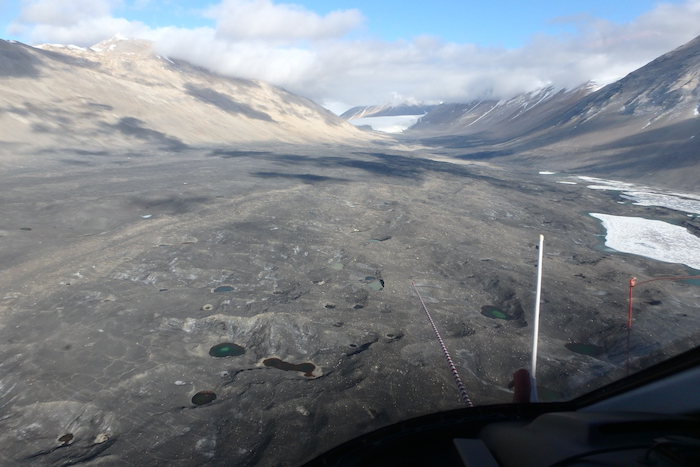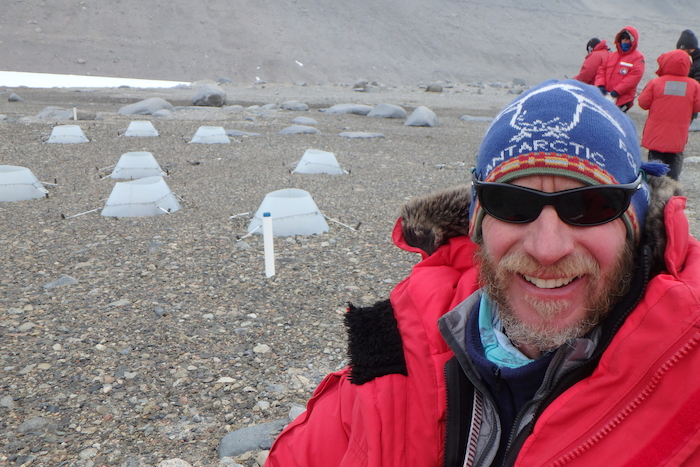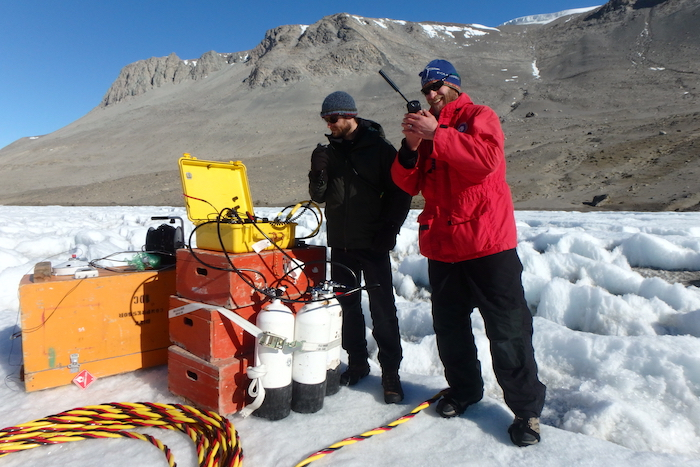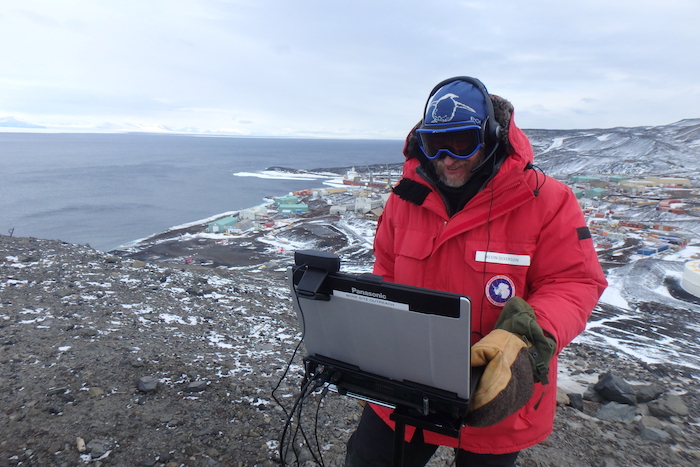PolarTREC Field Experience
My PolarTREC expedition to the Dry Valleys of Antarctica was an experience of a lifetime. Notice I did not use the word “trip” of a lifetime. This was far more than a trip. It was an experience that is a life-changer. It has been a life-changer for myself, my students, my family, other educators, and other folks who I have been able to share my Antarctic experience with.
The Importance of Teacher/Researcher Collaboration
The connections I made, and am still making, from my Antarctic PolarTREC experience with polar scientists and support personnel are a huge benefit to my teaching practice.
The Soil Team (affectionately known as the “Wormherders”) of the McMurdo Dry Valley Long Term Ecological Research (LTER) site, were my “Antarctic Family” for almost 2 months! They are all true science professionals. Prior to our expedition, I had met with our Dry Valley LTER science family and had gained a pretty clear vision of what this group was all about and what their goals were.
This relationship continues to this day. Members of my “Wormherder” team and I have continued our collaboration. Two months after our return, I was included in the Dry Valley LTER science summary meeting where the scientists reported the discoveries from their experiments. I have also had multiple conversations from my team members helping me troubleshoot my Soil Animal Extraction Lab, using the same techniques we used in Antarctica.

One team member even visited my class to help my students and assist with our lab. Dr. Byron Adams, the lead Principal Investigator (P.I.) for our team, set aside a half-day from his teaching and lab assignments at his university (BYU), to gather together with his colleagues and set up a polar symposium for my students. They presented their end-of-year projects to these professional scientists and were offered constructive motivational criticism. He then spent time showing the students his polar lab and even took the time to let the students see and handle his hominid skull collection and discuss human evolution.
I have met many other professionals in the last couple of years in the preparation and participation of my Antarctic experience. The connections that I made the last two years have branched out in so many directions. I have been introduced to many other professional scientists, master educators, beneficial organizations aside from PolarTREC such as Polar-ICE and the Sci-I program. I have learned from the many technology experts that have taught me new skills in photography, documentation, computer skills, visiting with the media, and even skills in outreach.
The Importance of Interdisciplinary Collaboration
For the past year, I have had the privilege of being a member of one of the largest interdisciplinary collaborative efforts in the world, the LTER Network. The NSF (National Science Foundation) provides funding to scientists who are doing long term ecological research on one of 28 sites around the world. Collaboration is a non-negotiable item all scientists involved in the LTER Network agree to do. Even the Antarctic Treaty Agreement states that “Scientific observations and results from Antarctica shall be exchanged and made freely available”. I have never heard of a better example of collaboration among the countries of the world than in Antarctica. Many countries from around the world have science stations in Antarctica. They all collaborate together to progress the science from the bottom of the Earth. In the words of Dr. Byron Adams, the lead scientist from my team, when asked about how well the countries get along in Antarctica, he said, “Scientists are lovers, not fighters”.
Summary of the Science
Antarctica, the 5th largest continent, is covered in ice. In some places, the ice is almost 5 kilometers thick! Only 1% of Antarctica that is not covered in ice. This area is known as the Dry Valleys. The National Science Foundation (NSF) realizes the importance of the science that can be done there and funds an LTER site there. 
The Dry Valley LTER team is divided into several specialty teams. Teams study climate and meteorology, glaciers, streams, lakes, soil, ecosystem modeling, and environmental history. Each of these teams spends time collecting data that they will then share with the entire LTER to try and complete the total picture of the Dry Valley ecosystem.
As I walked through the Dry Valleys, I felt as though I could be walking on Mars. There was nothing visibly alive other than our team members. I saw no plants or animals. It was a sterile-looking place.
Soon after we climbed off our helicopter that brought us to the Dry Valleys, we huddled up for last-minute instructions before getting to work collecting samples. I tried to follow the instructions exactly and got to work quickly. By the end of our first trip out into the Dry Valleys, which lasted about 4 days, we had collected several large coolers containing soil samples. 
We spent almost 2 months collecting soil from pre-determined sites where these “plots” had some sort of manipulation done. The manipulated variables included: temperature, elevation, high water flow events, wind distribution, added nutrients, and C02 released from the soil.
I now understand why NSF funds this LTER site. Since there are no plants or any animals above the soil in the Dry Valleys, there are fewer variables to mess up results from ecosystem experiments. There is no better location to study ecosystems than down in the Dry Valleys of Antarctica. Manipulate one variable in the ecosystem and learn how it will affect the rest of the ecosystem.
Another purpose of the Dry Valley LTER is the collection of long-term data, sometimes with no other reason than to collect this data for future testable questions that could be answered by looking at this long-term ecological data decades earlier. Long-term data sets show how ecosystems are trending. This data and modeling can then be used to extrapolate how ecosystems in our part of the world can change.
Linking PolarTREC to my Classroom, Audience, Institution, and Community
PolarTREC is NOT only about giving a few teachers the opportunity to have wonderful experiences working with polar scientists in faraway places. The PolarTREC program also benefits others that don't get to go on a polar expedition. PolarTREC teachers share experiences before, during, and after their expeditions through outreach and journaling. Teachers, students, and the community all benefit from the experiences and knowledge gained by PolarTREC teachers. My students attended PolarConnect events where they were able to participate in live video chats with polar scientists. My students have benefitted from many resources that PolarTREC teachers have posted on the PolarTREC website which allows free access to all.
No matter what the level of the learner, PolarTREC can benefit anyone. I have done outreach at a pre-school class, a university, many grade levels in a public school, along with the LTER Network meeting. It has been a rewarding experience sharing this treasured knowledge with others.
Bringing the Science Back to Students
Never before have I been more excited to share science with students than I have these past two years as I have been sharing polar science. I have learned the importance of what polar science can tell us about the rest of our world. The students have also appreciated this authentic science being presented to them.
Notice the title of this section does not say, “Bringing the Science Back to MY Students”. I have been able to share what I have experienced about Antarctica with many different students from around the country. Specifically, my students have had the opportunity to see the science being done live, via technology. They have chatted with Dr. Shawn Devlin, an Antarctic diver/scientist as he dove through 12 feet of ice at Lake Bonney to collect samples. 
Since I have returned from the expedition, it seems that nearly every day I am tying our daily topic into the science done in the Dry Valleys. My students have had members of my Dry Valley LTER team stop by their classroom and help them with their soil extraction lab techniques and also offer suggestions as they work on designing their Polar research projects. Members of the Antarctic team have even donated supplies to my students as they learn these extraction skills. My students have visited Dr. Adam’s lab at BYU where he spent several hours as my students presented their polar research and soil extraction labs to him and other professional scientist colleagues. Students are excited when they know the topic of the day will involve polar science and get to see some of my pictures or videos.
Linking to Classrooms
I have been “linking to classrooms” for the past two years. From the time I learned of PolarTREC and became involved in the Polar-ICE program, my class has been linked to polar science. As I did outreach to other schools prior to my deployment, I had more and more schools linked to this experience. Sharing these experiences live with the classrooms was a highlight of my expedition. 
Goals: Short-term/Long-term
Short-term:
- Organize and secure my treasured photos and videos.
- Make more videos from the expedition videos.
- Complete PolarTREC forms.
- Design sharable lessons from the science I did in the Dry Valleys.
- Continue to do as much outreach as possible.
- Order more business cards.
Long-term:
- Continue as much outreach as possible.
- Continue to link two best education programs I have been a part of - PolarTREC and Polar-ICE in my practice. Share this information with others.
- Help further promote PolarTREC wherever I can.
- Continue to assist Dr. Adams, and the rest of the McMurdo Dry Valley LTER, in whatever capacity might be privileged to help with.
Further Education and Outreach Opportunities
Along with further education with the Dry Valley LTER team, I plan to continue my involvement with the PolarTREC and Polar-ICE programs. I will continue to assist other teachers who have an interest in either of these programs. I have future outreach plans for my own school district science teachers and a large organization of home-schooled students.
Expedition Highlights
- Being stranded at our campsite, due to harsh weather, gave us time to get out and enjoy our magical surroundings.
- Assisting in world-class science with world-class scientists.
- Sharing the experiences, live, out in the harsh conditions of Antarctica.
- Learning of, and being a part of, the McMurdo Science Station culture.
- 24-hour sunshine
- Life-long friendships and numerous connections to world-famous professional scientists.
- Referring to Antarctic science…finally “Getting It”.
Top Takeaways
- Collaboration is alive and well in the science world.
- We are causing change to our world, not always for the better.
- Antarctica is worth protecting.

*This program is supported by the National Science Foundation under award 1345146. Any opinions, findings, and conclusions or recommendations expressed by this program are those of the PIs and coordinating team, and do not necessarily reflect the views of the National Science Foundation.
| Attachment | Size |
|---|---|
| Download Report3.21 MB | 3.21 MB |
This program is supported by the National Science Foundation. Any opinions, findings, and conclusions or recommendations expressed by this program are those of the PIs and coordinating team, and do not necessarily reflect the views of the National Science Foundation.
